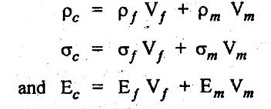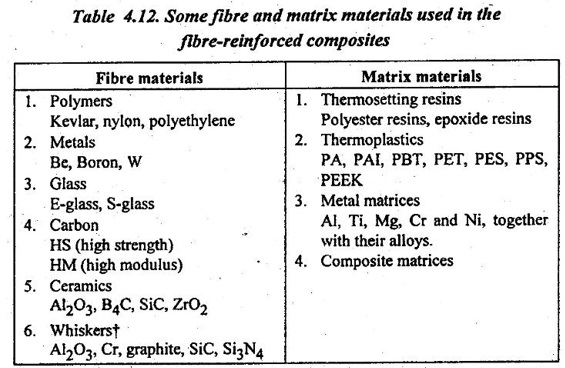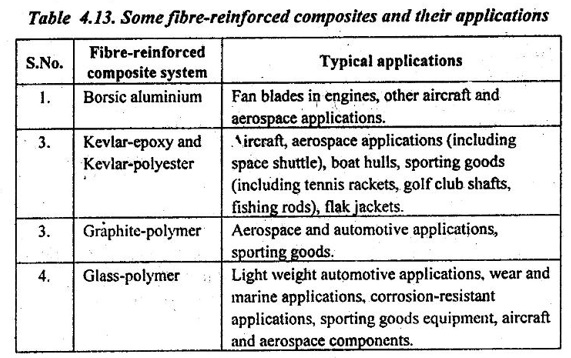Fibre-reinforced composites are those in which the dispersed phase is in the form of a fiber.
FIBRE-REINFORCED COMPOSITES
✔ Fibre-reinforced composites are those in which the dispersed phase is in the form of a fiber.
✔ In a fibre-reinforced composites, high-strength fibres are en- cased within a tough matrix.
✔ The functions of the matrix are :
(i) to bond the fibres together,
(ii) to protect them from damage, and
(iii) to transmit the load from one fibre to another.
✔ The greatest reinforcing effect is obtained when fibres are continuous and parallel to one another, and maximum strength is obtained when the composite is stressed in tension in a direction parallel to the line of fibres.
✔ When such a composite is stressed within the elastic range, the strain developed in both fibres and matrix will be the same. So the stresses induced in fibres and matrix will be proportional to the values of Young's modulus for each component.
✔ The expressions for density (ρ), tensile strength (σ), and modulus of elasticity (E), all have the same form.
They are given by

where V is the volume fraction, and suffices c, f, and m refer to composite, fibre, and matrix respectively.
✔ If fibres are discontinuous, their strengthening effect will be less than that of continuous fibres. Also short discontinuous fibres will be considerably less effective than long fibres.
✔ Most fibre-reinforced components provide improved strength, fatigue resistance, stiffness, and strength-to-weight ratio.
1. Characteristics of Fibre-Reinforced Composites
Many factors influence the characteristics of fibre-reinforced composites. The factors include:
1. The length, diameter, orientation, amount, and properties of the fibres.
2. The properties of the matrix.
3. The bonding between the fibres and matrix.
(i) Fibre length and diameter:
✔ Fibres can be short, long, or even continuous. Their dimensions are generally specified by the aspect ratio l/d, where l is the fibre length and d is the diameter.
✔ The strength of a composite improves when the aspect ratio is large and vice versa.
(ii) Amount of fibre:
A greater volume fraction of fibres increases the strength and stiffness of the composite.
(iii) Orientation of fibres:
✔ The reinforcing fibres may be introduced into the matrix in a number of orientations.
✔Short, randomly oriented fibres give relatively isotropic behaviour in the composite.
✔ Long, or even continuous, unidirectional arrangements of fibres produce anisotropic↑↑ properties, with particularly good strength and stiffness parallel to the fibres.
(iv) Fibre properties:
✔ If the composite is to be used at elevated temperatures, the fibre should have a high melting temperature.
✔ To achieve better mechanical properties, one should use fibres that have higher specific strength and specific modulus.
Specific strength of a fibre = σ / ρ and
Specific modulus of a fibre = E / ρ
where σ is the yield or tensile strength, ρ is the density, and E is the modulus of elasticity.
(v) Matrix properties:
✔ The matrix usually provides the major control over electrical properties, chemical behaviour, and elevated- temperature use of the composite.
† Isotropic: Having identical values of a property in all crystallographic directions.
†† Anisotropic: Exhibiting different values of a property in different crystallo- graphic directions.
✔ Depending upon the requirements, any one of the following matrices are selected :
1. Polymer matrices,
2. Metal matrices, and
3. Composite matrices.
(vi) Bonding and failure:
✔ The fibres must be firmly bonded to the matrix material so that the load can be properly transmitted from the matrix to the fibres.
✔ If fibre bonding is poor, the fibres may pull out of the matrix during loading. This will reduce the strength and fracture resistance of the composite.
✔ The coefficients of thermal expansion for the fibre and matrix materials should be similar. If the fibre expands and contracts at a rate much different from that of the matrix, fibres may break or bonding can be disrupted. This may cause premature failure.
2. Summary
Thus the fibre composites should have the following characteristics for their use :
1. Low relative density and hence high specific strength and modulus of elasticity.
2. Good resistance to corrosion.
3. Good fatigue resistance, particularly parallel to fibre direction.
4. Generally low coefficient of thermal expansion.
3. Fibre and Matrix Materials
Some of the commonly used fibre and matrix materials in the fibre- reinforced composites are listed in Table 4.12.

† Whiskers are very thin single crystals that have extremely large length-to- diameter ratios.
4. Examples of Fibre-Reinforced Composites
Some of the important fibre-reinforced composites and their typical applications are given in Table 4.13.

5. Advantages and Limitations of Composite Materials (Characteristics of Composite Materials)
Advantages
The advantages of composite materials are as follows:
1. Composite materials exhibit superior mechanical properties such as high strength, toughness, elastic modulus, fairly good fatigue and impact properties.
2. As fibre composites are light weight materials, the specific strength and specific modulus are much higher than the conventional materials.
3. In aerospace applications, the power-to-weight ratio is about 16 with composites compared to 5 with conventional materials.
4. The fabrication of composites to any desired shape and size can be achieved with ease.
5. They exhibit good corrosion resistance.
6. Assembly of components made of composites is much easy and quick.
7. They are not much sensitive to thermal shocks and temperature changes.
Limitations
The major drawbacks of using composites are :
1. Higher cost than many conventional materials.
2. Polymeric composites cannot be used for high temperature applications.
6. Applications of Composites
Composites find a wide variety of applications in many fields. Some of the important applications are listed in Table 4.14.
Table 4.14. Applications of composites
1. Commercial aircraft
Used for air conditioning duct, radar dome, landing gear door, seats, floorings, window reveals, ceiling panels, propeller blades, nose, wing body, elevators, ailerons, air brake, etc.
2. Military aircraft
Used for speed brake, rubber trunnion, forward fuselag, elevators, ailerons, landing gear doors, horizontal stabilizers, etc.
3. Missiles
Used for remote piloted vehicles, filament wound rocket motors, wings, rotor cases, etc.
4. Space hardwares
Used for antennas, struts, support trusses, trusses for telescopes, storage tanks for gases and fluids at cryogenic temperatures, etc.
5. Automobile and trucks
Used for drive shafts, bumpers, door and window frames, starter motor commutators, body panels, radiator and other hoses, timing and V belts, drive chains, etc.
6. Electrical and electronics
Used for microphone housing, miniature-electronic card holder, ribs to protect printed circuit boards, parabolic antenna, etc; electrical equipments switch casings, cable and distribution cabinets, junction boxes, etc.
7. Marine applications
Used for small boat hulls, sonar domes, masts, tanks, decks, submarine masts, spinnakar pole on the racing yatch, plates in nuclear submarine lead acid batteries, etc.
8. Sporting equipments
Used for tennis rackets, golf club shafts; bicycle components such as wheel, frame, forks, handlebars, pedal crank arms, package carriers, fenders, etc.; gliders; boats; sail boards.
9. Other applications
Other applications include bridge building; joint implants, heart valves; leaf springs; chemical industries application— for storing aggressive chemicals; wine vats and pipelines for water and sewage; in reinforced wood products, etc.
No comments:
Post a Comment